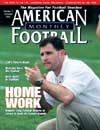AMERICAN FOOTBALL MONTHLY THE #1 RESOURCE FOR FOOTBALL COACHES
Article CategoriesAFM Magazine
|
Follow The LeaderChanging Trends Set the Pace in Footballby: Richard Scott © More from this issue When the University of Texas whipped out the wishbone in the 1960s, it didn't take long for college football programs all over the South to follow the trend and come up with their own version of the triple-option. When Florida coach Steve Spurrier brought a wide-open passing attack to the run-oriented SEC in the early 90s, it didn't take long for the rest of the conference to pick up on the trend and discover the joys of passing. When Nebraska and Kansas State starting using press-man defensive attacks with success in the 90s, opponents were quick to jump on the trend and add more pressure packages to their overall schemes. Trends. Good or bad, they're a part of our daily lives. Just look at the players. When many of today's coaches played college football, perhaps they wanted to wear their hair a little longer, or grow a musta....The full article can only be seen by subscribers.
|
|
|||||||
| HOME |
MAGAZINE |
SUBSCRIBE | ONLINE COLUMNISTS | COACHING VIDEOS |
Copyright 2025, AmericanFootballMonthly.com
All Rights Reserved





